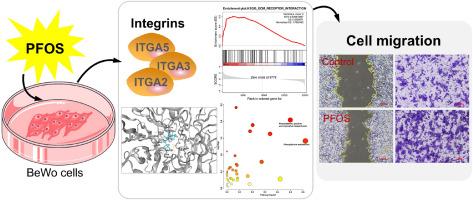Perfluorooctanesulfonic Acid Facilitates the Migration of Choriocarcinoma Cell Line BeWo: Integrins as Potential Target
IF 7.3
2区 环境科学与生态学
Q1 ENVIRONMENTAL SCIENCES
引用次数: 0
Abstract
The migration of placental trophoblasts is a crucial biological process essential for the maintenance of pregnancy. Perfluorooctanesulfonic acid (PFOS), a prototypical per- and polyfluoroalkyl substance, has been linked to a variety of adverse pregnancy outcomes. However, the regulatory effects and molecular mechanisms of PFOS on trophoblast migration, particularly at concentrations reflective of human internal exposure, remain inadequately explored. In this study, we utilized the BeWo choriocarcinoma cell model to evaluate PFOS effects on trophoblast migration at human internal exposure concentrations (0.02 μM, 0.2 μM, and 2.0 μM). Our findings reveal that PFOS significantly promotes trophoblast migration in a dose−dependent manner. Mechanistic profiling identified dysregulated activation of the extracellular matrix (ECM)-receptor interaction pathway and metabolic reprogramming, notably in amino acid metabolism, as potential drivers of this promoted migration. Further, integrin α5 (ITGA5), α3 (ITGA3), and α2 (ITGA2) were identified as putative molecular targets of PFOS. These findings, despite originating from BeWo choriocarcinoma cells model, provide novel mechanistic insights into the link between environmental PFOS exposure and placental dysfunction, thereby contributing to our understanding of the molecular basis underlying PFOS-associated pregnancy complications.

全氟辛烷磺酸促进绒毛膜癌细胞的迁移:整合素作为潜在靶点
胎盘滋养细胞的迁移是维持妊娠的重要生物学过程。全氟辛烷磺酸(PFOS)是一种典型的单氟烷基和多氟烷基物质,与各种不良妊娠结局有关。然而,全氟辛烷磺酸对滋养细胞迁移的调节作用和分子机制,特别是在反映人体内部暴露浓度的情况下,仍未得到充分探索。在本研究中,我们利用BeWo绒毛膜癌细胞模型,评估了PFOS在人体内部暴露浓度(0.02 μM, 0.2 μM和2.0 μM)下对滋养细胞迁移的影响。我们的研究结果表明,全氟辛烷磺酸以剂量依赖性的方式显著促进滋养细胞迁移。机制分析发现细胞外基质(ECM)-受体相互作用途径的激活失调和代谢重编程,特别是氨基酸代谢,是这种促进迁移的潜在驱动因素。进一步,整合素α5 (ITGA5)、α3 (ITGA3)和α2 (ITGA2)被确定为PFOS可能的分子靶点。这些发现,尽管来自BeWo绒毛膜癌细胞模型,但为环境全氟辛烷磺酸暴露与胎盘功能障碍之间的联系提供了新的机制见解,从而有助于我们了解全氟辛烷磺酸相关妊娠并发症的分子基础。
本文章由计算机程序翻译,如有差异,请以英文原文为准。
求助全文
约1分钟内获得全文
求助全文
来源期刊

Environmental Pollution
环境科学-环境科学
CiteScore
16.00
自引率
6.70%
发文量
2082
审稿时长
2.9 months
期刊介绍:
Environmental Pollution is an international peer-reviewed journal that publishes high-quality research papers and review articles covering all aspects of environmental pollution and its impacts on ecosystems and human health.
Subject areas include, but are not limited to:
• Sources and occurrences of pollutants that are clearly defined and measured in environmental compartments, food and food-related items, and human bodies;
• Interlinks between contaminant exposure and biological, ecological, and human health effects, including those of climate change;
• Contaminants of emerging concerns (including but not limited to antibiotic resistant microorganisms or genes, microplastics/nanoplastics, electronic wastes, light, and noise) and/or their biological, ecological, or human health effects;
• Laboratory and field studies on the remediation/mitigation of environmental pollution via new techniques and with clear links to biological, ecological, or human health effects;
• Modeling of pollution processes, patterns, or trends that is of clear environmental and/or human health interest;
• New techniques that measure and examine environmental occurrences, transport, behavior, and effects of pollutants within the environment or the laboratory, provided that they can be clearly used to address problems within regional or global environmental compartments.
 求助内容:
求助内容: 应助结果提醒方式:
应助结果提醒方式:


